MISTAKEPROOFING
in Architecture, Engineering, Construction, and Facilities Management (AECFM)
What is the Idea?
People make mistakes – to err is human – but we can reduce the likelihood that a mistake will occur or alleviate the impact of a mistake that has occurred.
Mistakeproofing (or poka yoke in Japanese) is the practice of designing products and processes to eliminate (or at least to reduce) the likelihood of occurrence of mistakes, and thereby avoid creating defects (or reduce their severity).
Mistakeproofing: It’s in the Cards
P2SL developed a unique poker-card game to illustrate practices of mistakeproofing in construction. The game is based on a framework that distinguishes 6 principles of mistakeproofing and the objective is to categorize examples according to these principles and in the process learn why some mistakeproofing practices are better than others.
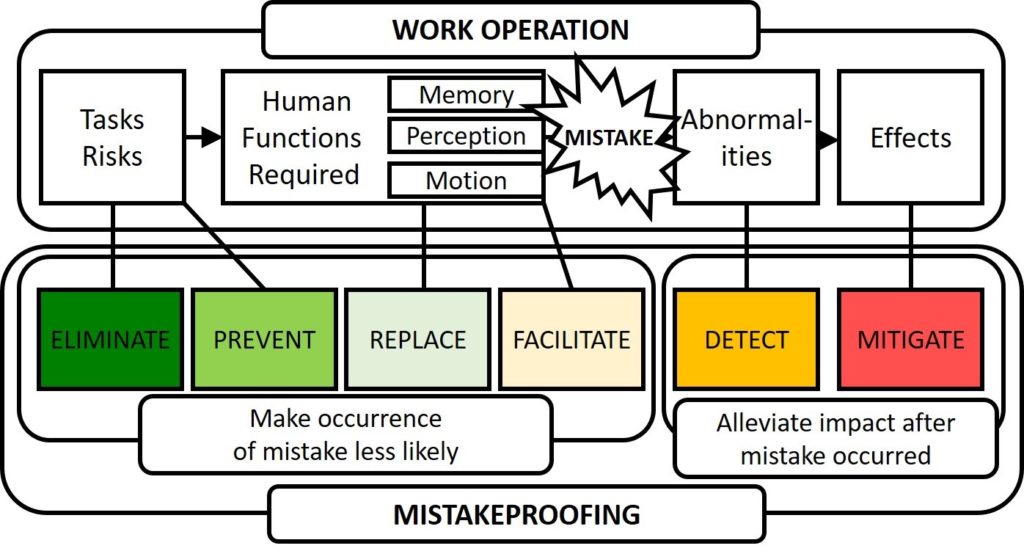
Lunch-and-Learn or a Workshop?
P2SL staff will be delighted to lead a lunch-and-learn or a half-day workshop focused on mistakeproofing for you and your team at your venue. Please reach out to us to discuss the possibilities.
When played in teams, the Mistakeproofing! game will lead to lively discussion as players come to grips with the foundational ‘zero defects’ concept. The game also encourages participants to share other examples that come to mind and talk about how to create your own.
To purchase a deck of cards and obtain the facilitator guide, reach out to p2sl@berkeley.edu (cost is $30 plus S&H).

(c) 2021 Iris D. Tommelein
Example Practices of Mistakeproofing
Color Coding


Colored drawing elements or Building Information Model (BIM):
Color coding of design drawing shows different wall types for drywall cost estimate
Source: DPR, Inc., Camino Medical Project.
Color-coded decking inserts:
Color coding shows locations for sheet metal straps and pipe hangers on metal decking
Source: John Mack, Southland Industries, Inc., presentation at 2007 LCI Annual Conference, San Francisco, CA.
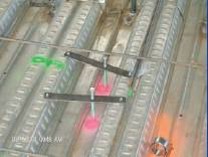
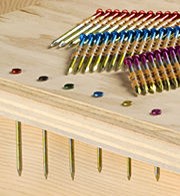
Colored nail heads:
The heads of these pneumatic nails have different colors to correspond to different lengths and diameters. This makes it easy to verify whether or not nails were installed according to a nailing schedule.
Source: Hawks, J. “Tool Review: Color-Coded Pneumatic Nails.” Fine Homebuilding Magazine reprinted on http://www.taunton.com/finehomebuilding/pages/h00090.asp visited 5/23/06.
Adaptability and Matching
Flexible water hose:
A flexible hose readily adjusts to the actual locations of the connection points. It does not require any trimming to length or bending at specific angles to match up with the connection points.
Source: Picture by Iris D. Tommelein, Boston, MA, 2007.
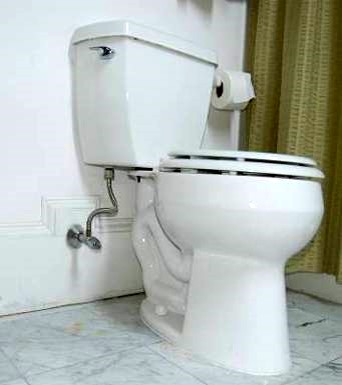
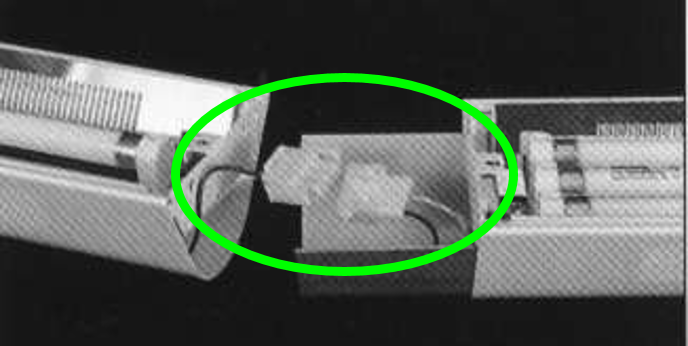
Electrical wire connector:
Connect plug for wiring of light fixtures avoids the possibility of crosswiring and reduces the time spent working overhead.
Source: Finelite product literature.
Butler Roof Sealant:
Sealant and return leg guarantee roof performance in terms of thermal expansion flexibility and watertightness.
Source: Butler manufacturing product literature; http://www.butlermfg.com/images/level3_pages/returnleglink-large.jpg visited 23 May 2006.
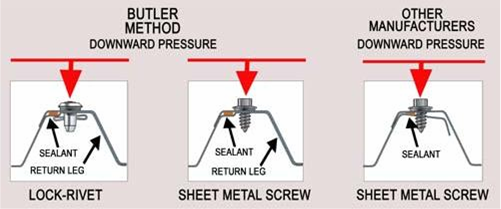
Mistakeproofing: A Mindset and Practice to Improve Construction Occupational Safety and Health
P2SL students and staff have been conducting research on mistakeproofing for some time and are seeking additional in-kind and financial support to further advance this initiative.
Publications to date include:
“Mistakeproofing the Design of Construction Processes Using Inventive Problem Solving” (Tommelein and Demirkesen 2018). An overview and findings of the research are presented next. A summary is posted at www.cpwr.com/wp-content/uploads/2018/04/KF2018-mistakeproofing-OSH.pdf and the report itself may be downloaded from www.cpwr.com/wp-content/uploads/publications/publications_Tommelein-mistakeproofing-construction-process.pdf.
We presented the conference paper “Principles of Mistakeproofing and Inventive Problem Solving (TRIZ)” stemming from this work at the 27th Annual Conference of the International Group for Lean Construction (IGLC27), held in Dublin, Ireland in 2019.
Funding for this research study was made possible by CPWR – The Center for Construction Research and Training through cooperative agreement U60-OH009762 from the National Institute for Occupational Safety and Health (NIOSH). The contents of the summary and the report are solely the responsibility of the authors and do not necessarily represent the official views of NIOSH or CPWR.
Overview
“Mistakeproofing” is the use of any device or method that either makes it impossible for an error to occur or makes the error immediately obvious once it has occurred. The objective of mistakeproofing is to reduce or eliminate the occurrence of errors, as they cause resource waste and defects. Mistakeproofing includes both labor and management: everyone can help identify opportunities to reduce or eliminate errors by applying mistakeproofing tools and practices through creative problem-solving. The authors explore how mistakeproofing applies in construction to reduce incidents and worker injuries, which are substantial sources of waste in the industry as they interrupt production, cost lost workdays, or result in other harm.
Key Findings
- The principles of mistakeproofing offer practical and useful application in the construction industry. Their systematic pursuit is bound to help improve quality performance, including safety and health performance.
- Quite a few applications of mistakeproofing already exist in the construction industry. Documentation of existing practices will inspire greater adoption of mistakeproofing.
- Developing a mistakeproofing mindset starts by raising awareness and empowering people to experiment with devices or methods in pursuit of continuous improvement. Training will be needed to foster a mistakeproofing mindset.
- The generation of new ideas on how to mistakeproof certain product or process designs can be supported by drawing on the principles of TRIZ (Theory of Inventive Problem Solving).
- The six principles of mistakeproofing align to some degree with the five levels in OSHA’s Hierarchy of Controls, in that both prioritize elimination and substitution of practices subject to human error.
Mistakeproofing in the Toyota Production System
Shigeo Shingo (1986), a consultant involved with the development of the Toyota Production System, introduced the concept of “poka yoke” (Japanese) or “mistakeproofing” (English) in his book titled Zero Quality Control: Source Inspection and the Poka-yoke System. This concept goes hand-in-hand with the concept of “jidoka” (Japanese) or “autonomation” (English) as together they form a pillar of the Toyota Production System.
Autonomation refers to machines built to detect problems and stop by themselves, so as to “relieve the burden of constantly supervising a machine, and allow [people] to use their talents for more beneficial things (like adding value)” (Liker and Meier 2006 p. 177). “The purpose of autonomation is the rapid or immediate address, identification and correction of mistakes that occur in a process. […] Once the line is stopped, a supervisor or person designated to help correct problems give immediate attention to the problem the worker or machine has discovered. To complete jidoka, not only is the defect corrected in the product where discovered, but the process is evaluated and changed to remove the possibility of making the same mistake again. This ‘mistakeproofing’ of the production line is called poka yoke.” (Superfactory 2008).
The premise of “zero quality control” is to “do it right the first time,” but Shingo also states (1986 p. 82): “I claim that it is impossible to eliminate all errors from any task performed by humans. Indeed, inadvertent errors are both possible and inevitable. Yet errors will not turn into defects if feedback and action take place at the error stage. Zero defects can be achieved because errors do not turn into defects (op. cit. p. 84) thanks to the use of a combination of source inspections and self-check systems.
We should “drop the idea that defects are a normal part of manufacturing” (Bodek’s preface in Shingo (1986 p. vii)). In the AEC industry, the notion that zero QC is contrary to the reliance of practitioners on inspection and punch lists as means to work towards an acceptable end product, hopefully one that is satisfactory and of quality!
To eliminate the need for quality control, the practice of mistakeproofing sets out to prevent errors or defects from occurring in the first place.

Mistakeproofing is particularly well suited for the AEC industry with its low-volume and high-variety production systems where statistical quality control methods cannot be implemented due to lack of data and un-timeliness of findings that result from after-the-fact data processing.
Mistakeproofing requires a different way of thinking about production processes and its constituent operations, but once practitioners have learned to recognize mistake proofing devices, their new mind-set will enable them to spot numerous opportunities available to mistake proof their workplace. They will find that many mistakeproofing practices can be implemented at a minimal cost, though some do require investment in new product development.
Mistakeproofing Resources
Glossary
- Mistakeproofing (also spelled mistake proofing or mistake-proofing): Mistakeproofing “or its Japanese equivalent poka-yoke (pronounced PO-ka yo-KAY), is the use of any automatic device or method that either makes it impossible for an error to occur or makes the error immediately obvious once it has occurred. It is a common process analysis tool.” (https://asq.org/quality-resources/mistake-proofing visited 2024-02-14) — Also called poka-yoke, errorproofing, failsafing
- Work Operation Framework: a depiction of mistakeproofing interventions one can take either before or after a mistake occurs.
For additional definitions of terms, consult the P2SL Glossary. This glossary is a work in progress. Email us if a term needs further clarification or if you wish to suggest that other words be included.
P2SL Publications
Tommelein, I.D. 2024. “Mistakeproofing! It’s in the Cards: A Serious Game.” Lean Construction Journal, www.leanconstructionjournal.org, doi.org/10.60164/ql7dq3pty or escholarship.org/uc/item/0qx8v9sm
Tommelein, I.D. 2023. Mistakeproofing game guide for facilitators. Project Production Systems Laboratory, UC Berkeley, 4 February, 7 pages, to be used with poker-card deck with examples. To purchase this facilitator guide and a deck of cards, reach out to p2sl@berkeley.edu (cost per set is $30 plus S&H).
Tommelein, I.D. 2019. “Principles of Mistakeproofing and Inventive Problem Solving (TRIZ).” In: Proceedings of the 27th Annual Conference of the International Group for Lean Construction (IGLC 27), Pasquire, C. and Hamzeh, F.R. (eds.), Dublin, Ireland, online at https://www.iglc.net/Papers/Details/1710 – Best IGLC Paper: Second Place Award.
Tommelein, I.D. 2008. “‘Poka Yoke’ or Quality by Mistake Proofing Design and Construction Systems.” In: P. Tzortzopoulos and M. Kagioglou (Eds.), Proceedings of the 16th Annual Conference of the International Group for Lean Construction, (IGLC 16), 16-18 July, Manchester, UK, July 2008, pp. 195-205, https://www.iglc.net/Papers/Details/614/pdf
Tommelein, I.D. 2008. “Mistake-Proofing Design and Construction Systems Improves Quality of Capital Projects.” Tradeline Leading-edge Resources for Facilities Planning and Management, November 19 (this document used to be online at http://www.tradelineinc.com/).
Tommelein, I.D. and Demirkesen, S. 2018. Mistakeproofing the Design of Construction Processes Using Inventive Problem Solving (TRIZ). Final Report for CPWR Small Study No. 16-3-PS, CPWR, Silver Spring, MD, 60 pp., available for free download from dx.doi.org/10.34942/P2QP4V
Tommelein, I.D. and Yiu, K. 2022. “Mistakeproofing framework and applications in civil engineering operations and products.” ASCE, Construction Research Congress 2022, 9-12 March, Arlington, VA, pp. 617-626, doi.org/10.1061/9780784483978.063
Additional Reading
Bodek, N. (1986). Page vii of Publisher’s Preface to Shingo (1986).
dos Santos, A. and Powell, J. (1999). “Potential of poka-yoke devices to reduce variability in construction.” Proc. 7th Ann. Conf. Int’l. Group for Lean Constr., Berkeley, CA, pp. 51-62.
dos Santos, A., Powell, J., and Formoso, C.T. (1999). “Evaluation of Current Use of Production Management Principles in Construction Practice.” Proc. 7th Ann. Conf. Int’l. Group Lean Constr., Berkeley, CA, pp. 73-84.
dos Santos, A., Powell, J., Sharp, J., and Formoso, C.T. (1998). “Principle of transparency applied in construction.” Proc. 6th Ann. Conf. Int’l. Group for Lean Construction, Guaruja, Brazil.
Finelite (2001). The Affordable Alternative – Contractor Guide. Finelite Inc., Union City, CA, http://www.finelite.com/, 20 pp.
Finelite (2008). Estimator and Contractor Guide. Available online at http://www.finelite.com/contractor/ContractorGd_m.pdf visited 22 April.
Grout, J. (2007). Mistake Proofing the Design of Health Care Processes. Agency for Healthcare Research and Quality (AHRQ).
Liker, J.K. and Meier, D. (2006). The Toyota Way Fieldbook. McGraw-Hill, 475 pp.
Shingo, S. (1986). Zero Quality Control: Source Inspection and the Poka-yoke System. Productivity Press, Cambridge, Mass.
Superfactory (2008). See jidoka on website http://www.superfactory.com/ visited on May 5th.
Tommelein, I.D. (2008). “‘Poka Yoke or Quality by Mistake Proofing Design and Construction Systems” In Tzortzopoulos, P. and Kagioglou, M. (Eds.). Proceedings of the 16th Annual Conference of the International Group for Lean Construction (IGLC 16), 16-18 July, Manchester, UK.
Tommelein, I.D. 2019. “Principles of Mistakeproofing and Inventive Problem Solving (TRIZ).” Proceedings of the 27th Annual Conference of the International Group for Lean Construction (IGLC27), Dublin, Ireland, 3-5 July, pp. 1401-1412, doi.org/10.24928/2019/0129.
Tommelein, I.D. and Demirkesen, S. (2018). “Mistakeproofing the Design of Construction Processes Using Inventive Problem Solving.” Final Report for CPWR Small Study No. 16-3-PS, Center for Construction Research and Training, Silver Spring, MD, February, https://escholarship.org/uc/item/8ks2m091.